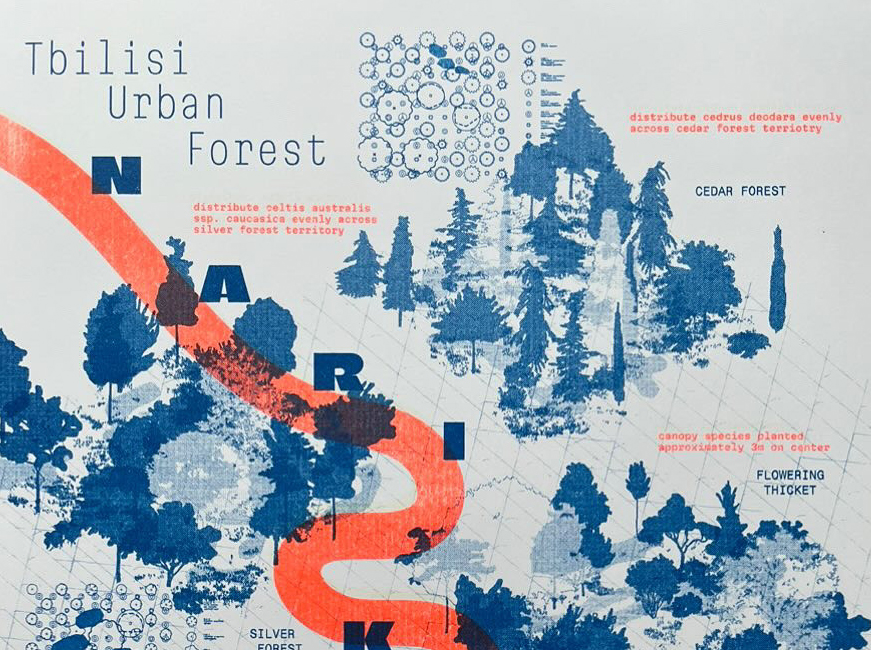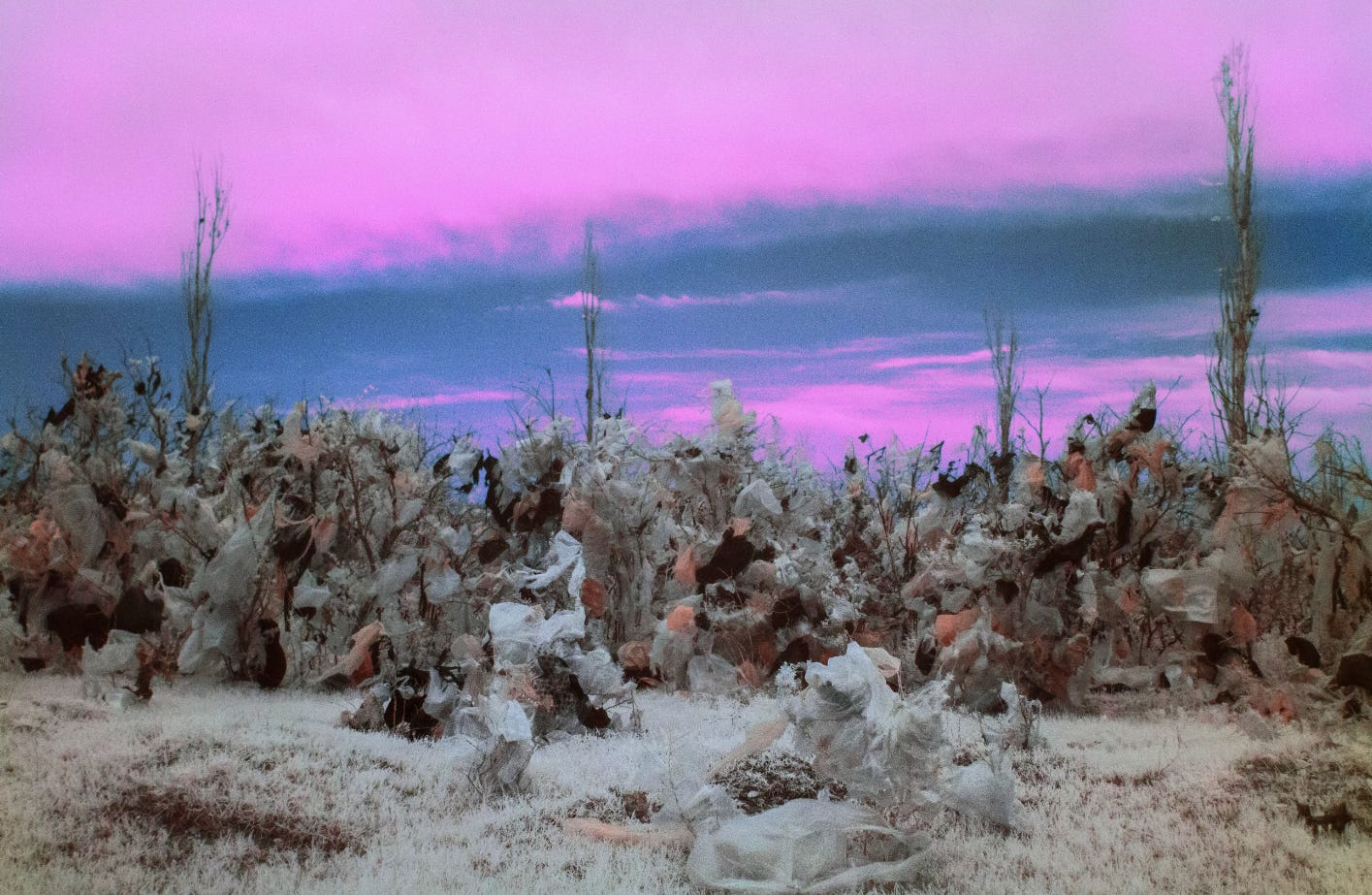Dighomi Meadows is a landscape of ruderal plants and hundreds of piles of construction waste on top of a now buried riparian forest in the north of Tbilisi in Georgia.
[Read more: From Academia to Activism at the Dighomi Meadows]
The full 190 hectares of the floodplain has been slowly destroyed by surface mining and illegal dumping since 2015, but my thesis research focused on just one hectare, reshaped by illegal dumping between December 2019 and April 2020.
Rehabilitation strategies for the site are being developed, those strategies are constrained by both the frameworks of large multinational donors, and the challenges of taking on a site of this size. I was interested in approaches to the site that were more playful and exploratory; seeing where engaging with it as a site of both destruction and regeneration could lead a design, particularly in light of there being large numbers of similar sites across Georgia.
My research focused on whether the meadows’ ecological and recreational functions could be rehabilitated without romanticising or hiding the story of their destruction. In order to do so, I found myself in need of exploring an approach to landscape architecture that was completely unexplored in the Danish scene as far as I knew.
The philosophy behind my approach was inspired by Anna Tsing’s book The Mushroom at the End of the World as well as Gilles Clement’s Manifesto of the Third Landscape. In Tsing’s book, she explores nature that develops after human destruction, which Tsing terms ‘third nature’, with a focus on its development resulting from human intervention, while not being controlled by it.
Clement, on the other hand, describes his third landscapes as being abandoned and ‘undecided’ spaces that ‘[express] neither power nor submission to power’, creating a neat connection between ‘third nature’ and ‘third landscape’. In Dighomi Meadows, I saw a third landscape rising from human destruction, and I saw ruderal vegetation — third nature — that was slowly colonizing the landscape, bringing life to a place that had been destroyed.
Conversations with Sarah Cowles and Ben Hackenberger at Ruderal helped me to find the tools I needed to bring this philosophy into the world of design, particularly the ideas of using ‘disturbance as design’ and seeing the surpluses of an unbalanced landscape as the key to unlocking it. With those principles, tools, several site visits and multiple consultations with my supervisor Megan Maurer and my colleagues at Ruderal , I put together a design for the site.
Geodiversity and ‘surprise’ seeds
A key tenet of my approach to the site was to frame the impacts of what could have been viewed as degradation of the site as a feature and even an opportunity.
For example, the dumping of a diversity of waste materials at the Dighomi Meadows has led to surprisingly high geodiversity at the site. This diversity of structures, minerals, and hydrological conditions creates the conditions for equally varied biodiversity, as it generates an abundance of habitats in a small amount of space.
Similarly, the site’s seed bank includes not only native species from the site’s riparian forest and wind-borne ruderal species, but also a contingent of ‘surprise’ seeds that have been brought to the site within the mounds of waste.
Animals from the riparian forest — turtles, tortoises, birds, snakes, insects — have established habitats in the new landscape, with the site’s flora and fauna transforming the site over four years from a site characterized by waste and destruction to a coarse, chaotic, but dense and diverse meadow.
My design showcases some of that diversity, using the waste mounds as a feature of the landscape, rather than an obstacle.
My final design centers on a series of narrow walking paths that connect the different corners of the site, moving both between and across the mounds. The paths following existing paths seen in drone footage and site visits. The paths also connect four interventions: The Island Bridge, The Edge of Reason, The Supra Grove, and The Heart of Dighomi. The interventions all aim to acknowledge the landscape’s past while creating ways for people to engage with the site.
The first intervention, the Island Bridge, shapes a visitor’s first encounter with the meadows. Excavating earth from the west entrance and reestablishing access with a bridge mimicking the tire tracks transecting the site creates the feeling of entering an island, and more firmly separates the experience of being outside the meadows from that inside. The entrance is a natural low point, with excavation bringing this even further down, inviting plants more adapted to wet conditions to grow under the new bridge.
The Edge of Reason, on the other hand, takes visitors up to a viewing point, with a blue railing at the top of a steep four meter slope establishing a viewpoint. The barrier of the railing then becomes a handrail, leading the visitor through a small group of invasive Amorpha Fruticosa and onto a small platform at the water’s edge. This is the only access a visitor has to the water and it is the only place the visitor sees the old landscape at eyeheight, getting a clear impression of the vast size of the new landscape.
The design also seeks to engage with how people interact with outdoor spaces in Georgia, and the ways in which people living in the area and Georgian visitors might want to engage with the site. The Supra Grove uses deliberately placement of rock piles in a flat area of the landscape to encourage tree growth, that over time could produce a shaded grove reminiscent of those used for feasts or ‘supras’ in many natural Georgian forests. The intervention is by no means a guarantee of a shaded grove, but its prospect is encouraged by a quick progression of existing Populus, Tamarix, and Carpinus between the piles that make up the borders of the Supra Grove and across the entire site.
Finally, the Heart of Dighomi takes on a site where existing flora is being quite literally pushed out of existence, and creates an opportunity to bring about new life. In the north east of the intervention area, five poplars from the old landscape are rapidly dying due to the pressure exerted by waste on their root collars. However, beneath the crowns of the decaying trees, the mounds of river rock are rapidly being recolonised by young poplars and other trees.
In my design, a raised path of framed steel grates leads off from the main path across several piles of limestone, through the young and vibrant rubble forest. Two irrigation tubes are placed between the mounds, loosely following the path. The tubes are similar to the ones that slither through the northern riparian forest, transporting irrigation water to the football fields in the Olympic Village. One tube is attached to one of the dying trees, pumping water into the hole that surrounds it. The other coils around a fallen tree onto a flat piece of land, letting water out onto the trunk which then follows the terrain down into the depression around the last poplar tree of the pre-destruction generation to remain somewhat alive.
The water changes the two trees’ decomposition process from aerobic to anaerobic, and creates varying degrees of wetness in the area, inviting plants more adapted to wet conditions to recolonise the former floodplain.
In these interventions, I deliberately chose not to clean the area or remove broken plastic from the mounds: I wanted the destruction that created the landscape to be visible and tangible. By removing plastic or focusing on making the site as conventionally beautiful and pleasing as possible, the intervention would run the risk of erasing the story of the site’s destruction, romanticizing and simplifying the site’s rehabilitation.
I did not want to create a project that claims that we can have the same ‘nature’ after we destroy a landscape as we had before. I wanted to create a landscape where the violence and loss of destruction sits alongside the beauty of nature’s own rehabilitation. Walking in the area, we never lose the feeling of the landscape being unnatural, but by diving into the diversity and heterogeneity of the landscape and the vegetation, we can recognise that the landscape and its reclamation can at the same time be ‘natural’ in its post-human, ruderal development. The vegetation that develops after destruction is still nature, even if it grows from tainted soil.
Such an approach to nature reframes value systems and common assumptions: by only seeing value in untouched nature, we will soon see no value at all, and by learning to see value in an area like Dighomi Meadows, we slowly begin to see value everywhere.
This is not to suggest that destroying ancient ecosystems is justified, but in a context where it will happen regardless, we need to begin to find value in new landscapes that emerge from that destruction, and recognise the richness of ‘third nature’.
editor - Anna Edgar
Read on Substack

